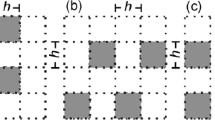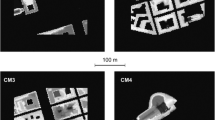Abstract
The effect of wind environment is becoming increasingly important in analyzing and selecting sites for better natural ventilation of residential buildings, external comfort, and pollution dispersion. The main purpose of this study was to develop a set of methods for wind environment assessment in coastal concave terrains. This set of methods can be used to provide quantifiable indicators of preferable wind conditions and help site analysis. Firstly, a total of 20 types of coastal bays with concave terrains in East Asia were characterized to find ideal locations. The selected areas were divided into five categories according to the main terrain features. Then a sample database for the concave terrains was compiled for modelling comparisons. Secondly, a number of key wind variables were identified. Computational fluid dynamics (CFD) models of the typical coastal concave terrains identified as a result of the study were created, and the local wind environments were simulated with input from geographic information system (GIS) and statistic package for social science (SPSS) analysis. A measure of wind suitability was proposed that takes wind velocity and wind direction into account using GIS. Finally, SPSS was used to find the relationship between wind suitability and key terrain factors. The results showed that wind suitability was significantly associated with terrain factors, especially altitude. The results suggest that residential building sites should be selected such that their bay openings face the direction of the prevailing wind and that the opposite direction should be avoided.
中文概要
目的
风环境直接影响居住建筑室内外自然通风、舒适度以及污染物扩散情况。本文以居住建筑选址分析为目的,建立一系列针对东亚沿海岙型地形的风环境评价方法,分析影响风环境特点的主要因素,提出风适宜度评价模型,探讨风环境与主要地形因子之间的相关性。
创新点
1. 建立东亚沿海典型岙型地形的分类数据库;2. 提出基于选址分析的风适宜度模型;3. 建立风适宜度与地形因子之间的回归模型。
方法
1. 通过CFD 模拟的方法,计算典型工况下20 种岙型地形的风场(图5);2. 通过理论分析和数理耦合的方法,构建风适宜度模型(公式(4));3. 通过Logistic 回归方法,分析风适宜度与地形因子的相关性。
结论
1. 风适宜度直接受地形特征影响,开口面向来风向的岙型地形中风适宜度平均值最高,选址过程中应避开开口背向来风向的岙型地形;2. 通过多元回归分析得出风适宜度和地形因子的相关性显著,其中海拔是决定风适宜度的主要地形因子。
Similar content being viewed by others
References
Bowen, A.J., Hong, C., 1992. The measurement and interpretation of peak-gust wind-speeds over an isolated hill. Journal of Wind Engineering & Industrial Aerodynamics, 41(1–3): 381–392. http://dx.doi.org/10.1016/0167-6105(92)90436-E
Bullard, J.E., Wiggs, G.F.S., Nash, D.J., 2000. Experimental study of wind directional variability in the vicinity of a model valley. Geomorphology, 35(1–2): 127–143. http://dx.doi.org/10.1016/S0169-555X(00)00033-7
Castro, F.A., Palma, J.M.L.M., Lopes, A.S., 2003. Simulation of the Askervein Flow. Part 1: Reynolds Averaged Navier-Stokes equations (k∈turbulence model). Boundary-Layer Meteorology, 107(3): 501–530. http://dx.doi.org/10.1023/A:1022818327584
Cheng, X.L., Fei, H.U., 2006. The study of grid formation on complex terrain. Chinese Journal of Computational Mechanics, 23(3): 313–316 (in Chinese).
Chock, G.Y.K., Cochran, L., 2005. Modeling of topographic wind speed effects in Hawaii. Journal of Wind Engineering, 93(8): 623–638.
Dai, N., Miura, O., 1997. Soil disturbance regime in relation to micro-scale landforms and its effects on vegetation structure in a hilly area in Japan. Plant Ecology, 133(2): 191–200.
Hu, C.H., Wang, F., 2005. Using a CFD approach for the study of street-level winds in a built-up area. Building & Environment, 40(5): 617–631. http://dx.doi.org/10.1016/j.buildenv.2004.08.016
Kubota, T., Miura, M., Tominaga, Y., et al., 2008. Wind tunnel tests on the relationship between building density and pedestrian-level wind velocity: development of guidelines for realizing acceptable wind environment in residential neighborhoods. Building & Environment, 43(10): 1699–1708. http://dx.doi.org/10.1016/j.buildenv.2007.10.015
Kumar, S., Bansal, V.K., 2016. A GIS-based methodology for safe site selection of a building in a hilly region. Frontiers of Architectural Research, 5(1): 39–51. http://dx.doi.org/10.1016/j.foar.2016.01.001
Latinopoulos, D., Kechagia, K., 2015. A GIS-based multicriteria evaluation for wind farm site selection. A regional scale application in Greece. Renewable Energy, 78: 550–560. http://dx.doi.org/10.1016/j.renene.2015.01.041
Launder, B.E., Sharma, B.I., 1974. Application of the energydissipation model of turbulence to the calculation of flow near a spinning disc. Letters in Heat and Mass Transfer, 1(2): 131–137. http://dx.doi.org/10.1016/0094-4548(74)90150-7
Lei, L.I., Chan, P.W., Yang, L., et al., 2013. Study on numerical simulation of wind field around buildings over complex terrain. Journal of Tropical Meteorology, 6(10): 77–81 (in Chinese).
Li, W., Wang, F., Bell, S., 2007. Simulating the sheltering effects of windbreaks in urban outdoor open space. Journal of Wind Engineering and Industrial Aerodynamics, 95(7): 533–549. http://dx.doi.org/10.1016/j.jweia.2006.11.001
Liu, D., Zhao, F.Y., Tang, G.F., 2010. Non-unique convection in a three-dimensional slot-vented cavity with opposed jets. International Journal of Heat and Mass Transfer, 53(5–6): 1044–1056. http://dx.doi.org/10.1016/j.ijheatmasstransfer.2009.11.006
Mak, M.Y., Ng, S.T., 2005. The art and science of Feng Shui—a study on architects’ perception. Building and Environment, 40(3): 427–434. http://dx.doi.org/10.1016/j.buildenv.2004.07.016
McAuliffe, B.R., Larose, G.L., 2012. Reynolds-number and surface-modeling sensitivities for experimental simulation of flow over complex topography. Journal of Wind Engineering & Industrial Aerodynamics, 104-106(3): 603–613. http://dx.doi.org/10.1016/j.jweia.2012.03.016
Meaden, G.T., Kochev, S., Kolendowicz, L., et al., 2007. Comparing the theoretical versions of the Beaufort scale, the T-scale and the Fujita scale. Atmospheric Research, 83(2–4): 446–449. http://dx.doi.org/10.1016/j.atmosres.2005.11.014
Mellor, G.L., Yamada, T., 1982. Development of a turbulent closure model for geo-physical fluid problems. Reviews of Geophysics, 20(4): 851–875. http://dx.doi.org/10.1029/RG020i004p00851
MHURD (Ministry of Housing and Urban-Rural Development), 2014. Evaluation Standards of Green Building, GB/T 50378-2014. National Standards of People’s Republic of China (in Chinese).
Murakami, S., Deguchi, K., 1981. New criteria for wind effects on pedestrians. Journal of Wind Engineering & Industrial Aerodynamics, 7(3): 289–309. http://dx.doi.org/10.1016/0167-6105(81)90055-6
Murakami, S., Iwasa, Y., Morikawa, Y., 1986. Study on acceptable criteria for assessing wind environment at ground level based on residents’ diaries. Journal of Wind Engineering and Industrial Aerodynamics, 24(1): 1–18.
Noorollahi, Y., Yousefi, H., Mohammadi, M., 2016. Multicriteria decision support system for wind farm site selection using GIS. Sustainable Energy Technologies and Assessments, 13: 38–50. http://dx.doi.org/10.1016/j.seta.2015.11.007
Penwarden, A.D., 1973. Acceptable wind speeds in towns. Building Science, 8(3): 259–267. http://dx.doi.org/10.1016/0007-3628(73)90008-X
Ramponi, R., Blocken, B., Coo, L.B.D., et al., 2015. CFD simulation of outdoor ventilation of generic urban configurations with different urban densities and equal and unequal street widths. Building and Environment, 92: 152–166. http://dx.doi.org/10.1016/j.buildenv.2015.04.018
Simiu, E., Scanlan, R.H., 1978. Wind Effects on Structures: an Introduction to Wind Engineering. John Wiley, USA.
Sugimura, T., Takahashi, K., Iida, M., 2009. Numerical wind analysis on complex topography using multiscale simulation model. The seventh International Conference on Urban Climate.
Szűcs, Á., 2013. Wind comfort in a public urban space–case study within Dublin Docklands. Frontiers of Architectural Research, 2(1): 50–66. http://dx.doi.org/10.1016/j.foar.2012.12.002
Takahashi, T., Ohtsu, T., Yassin, M.F., et al., 2002. Turbulence characteristics of wind over a hill with a rough surface. Journal of Wind Engineering & Industrial Aerodynamics, 90(12–15): 1697–1706. http://dx.doi.org/10.1016/S0167-6105(02)00280-5
Takahashi, T., Kato, S., Murakami, S., et al., 2005. Wind tunnel tests of effects of atmospheric stability on turbulent flow over a three-dimensional hill. Journal of Wind Engineering and Industrial Aerodynamics, 93(2): 155–169. http://dx.doi.org/10.1016/j.jweia.2004.11.003
Tamura, T., 1969. A series of micro-landform units composing valley-heads in the hills near Sendai. Control Theory & Applications IEE Proceedings D, 127(4): 177–187.
Tamura, T., 1983. Multiscale landform classification on study in the hills of Japan: Part III application of the multiscale landform classification system to environmental geomorphological studies in the hills. The Science Reports of the Tohoku University, 33(2): 79–103.
Tang, L., Nikolopoulou, M., Zhao, F.Y., et al., 2012. CFD modeling of the built environment in Chinese historic settlements. Energy and Buildings, 55(12): 601–606. http://dx.doi.org/10.1016/j.enbuild.2012.09.025
Taylor, P.A., Walmsley, J.L., Salmon, J.R., 1986. Guidelines and models for estimating wind speeds at WECS sites in complex terrain. Proceedings of the Ninth Biennial Congress of the International Solar Energy Society, 4: 2009–2014. http://dx.doi.org/10.1016/B978-0-08-033177-5.50378-1
Vuorinen, V., Chaudhari, A., Keskinen, J.P., 2015. Large-eddy simulation in a complex hill terrain enabled by a compact fractional step OpenFOAM® solver. Advances in Engineering Software, 79: 70–80. http://dx.doi.org/10.1016/j.advengsoft.2014.09.008
Weng, W., Taylor, P.A., Walmsley, J.J., 2000. Guidelines for airflow over complex terrain: model developments. Journal of Wind Engineering & Industrial Aerodynamics, 86(2–3): 169–186. http://dx.doi.org/10.1016/S0167-6105(00)00009-X
Wise, A.F.E., Richards, D.J.W., 1971. Effects due to groups of buildings. Philosophical Transactions of the Royal Society A: Mathematical Physical and Engineering Sciences, 269(1199): 469–485.
Yan, B.W., Li, Q.S., 2016. Coupled on-site measurement/CFD based approach for high-resolution wind resource assessment over complex terrains. Energy Conversion and Management, 117: 351–366. http://dx.doi.org/10.1016/j.enconman.2016.02.076
Author information
Authors and Affiliations
Corresponding author
Additional information
Project supported by the National Natural Science Foundation of China (Nos. 51208466 and 51238011), the Science and Technology Research Program of Chinese Ministry of Housing and Urban-Rural Development (No. 2014R2-036), the Humanities and Social Sciences Research Foundation of the Ministry of Education (No. 17YJAZH136), the Natural Science Foundation of Zhejiang Province (No. LY16E0 80011), and the Social Sciences Planning Project of Zhejiang Province (No. 12JCSH02YB), China
Rights and permissions
About this article
Cite this article
Zhu, Xq., Weng, Jt., Wu, Yq. et al. Wind suitability in site analysis of coastal concave terrains using computational fluid dynamics simulation: a case study in East Asia. J. Zhejiang Univ. Sci. A 18, 741–756 (2017). https://doi.org/10.1631/jzus.A1600313
Received:
Accepted:
Published:
Issue Date:
DOI: https://doi.org/10.1631/jzus.A1600313
Key words
- Wind suitability
- Residential building
- Computational fluid dynamics (CFD)
- Coastal concave terrains
- East Asia




